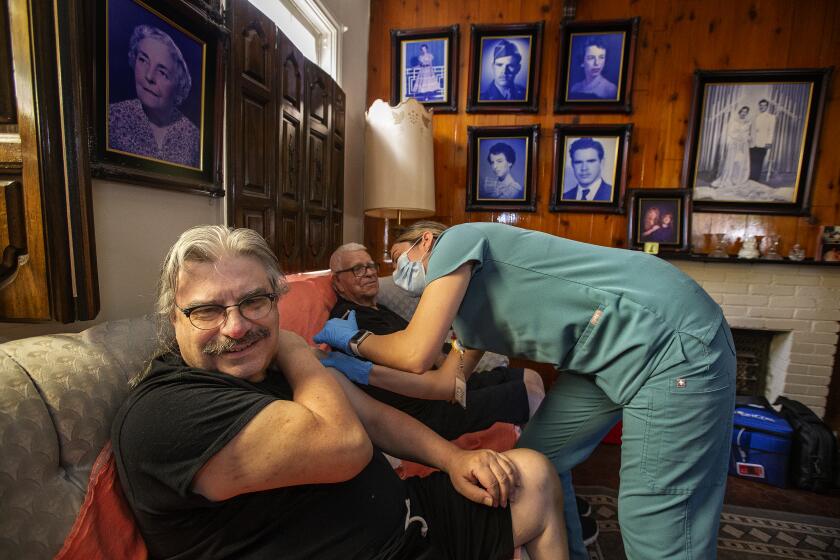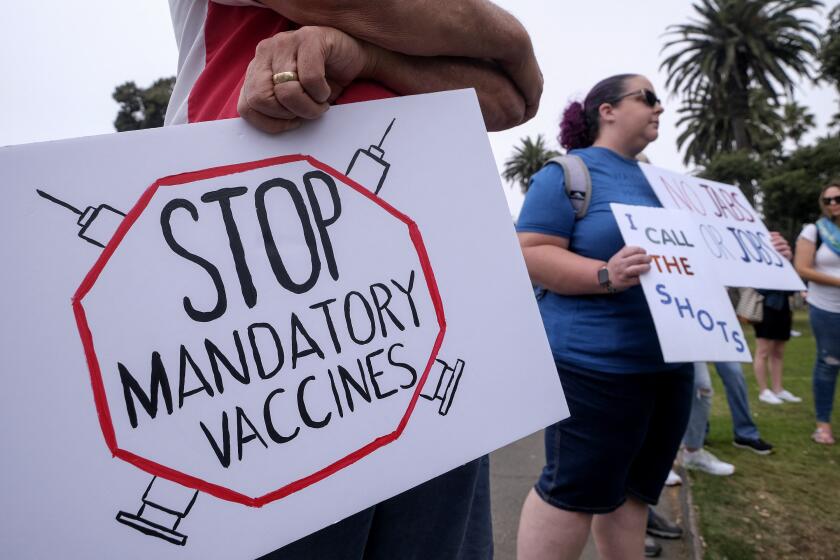COVID-19 still a leading cause of death in L.A. County, even amid ‘milder’ Omicron surge
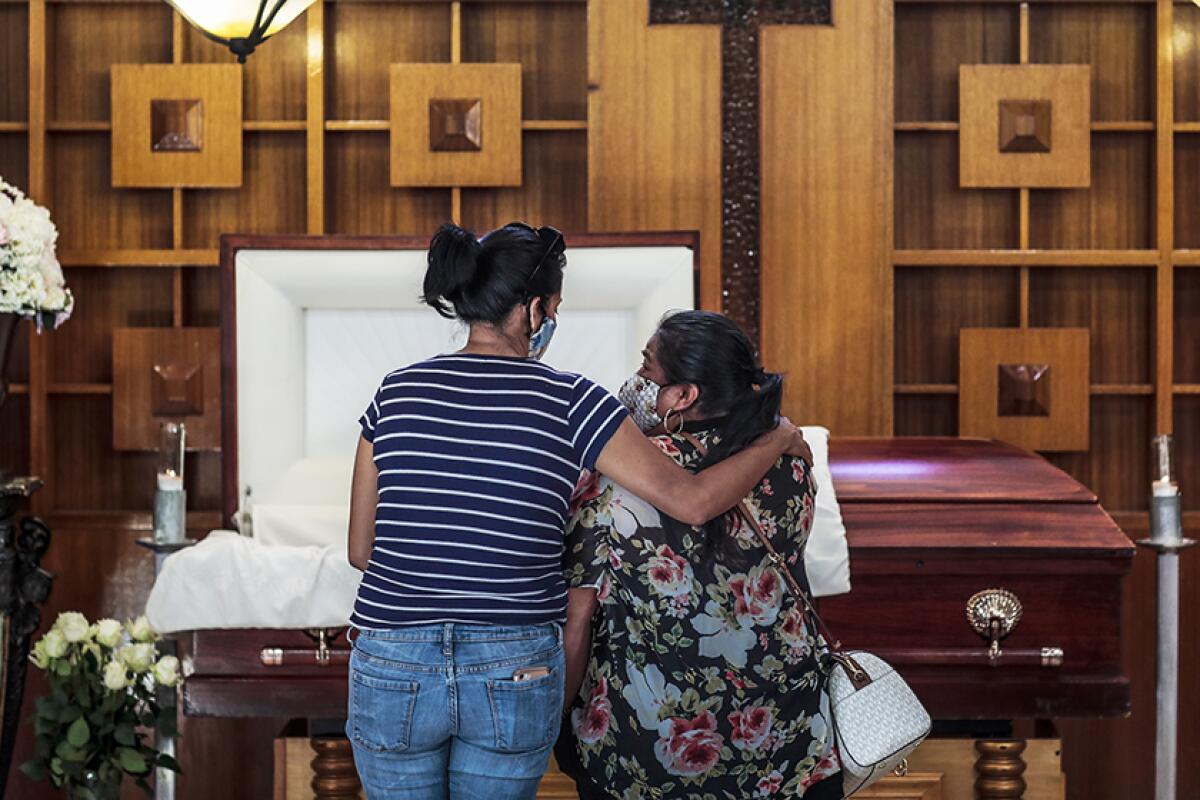
- Share via
The coronavirus continues to play an outsized role in the mortality rate in Los Angeles County, new data from the Department of Public Health show.
According to an analysis from the county health department, COVID-19 was the second-leading cause of death in the first six months of 2022, illustrating the outsized impact the pandemic has had on mortality rates despite widespread availability of vaccines and the arguably less-severe Omicron strain.
By contrast, COVID-19 was the leading cause of death in the nation’s most populous county in the first six months of 2021, a span that includes the deadliest surge of the 2½-year pandemic. And for the comparable period in 2020, COVID-19 was the second leading cause of death, even though the coronavirus did not begin to spread widely until March.
From January through June of this year, the COVID-19 mortality rate of 30.1 deaths for every 100,000 residents was second only to coronary heart disease, which had a rate of 47.5. Lagging behind was the death rate for diabetes, which was 15.5, and flu and pneumonia, which was 7.1.
The data underscore how COVID-19, during California’s last winter surge, was still far more deadly than the flu, according to L.A. County public health director Barbara Ferrer.
“The mortality rate from COVID-19 is more than four times greater than the mortality rate from pneumonia and influenza combined,” Ferrer said at a news briefing recently.
A confluence of respiratory illnesses has some California officials warning of a possible triple threat that could strain healthcare systems.
The L.A. County data match national trends, which also show that COVID-19 was one of the leading causes of death during the pandemic.
That said, the first half of 2022 was significantly less deadly than the same span in 2021, when vaccines were first being rolled out and still in short supply. The COVID-19 death rate then — 95.9 deaths for every 100,000 residents — was three times as high as during the same time in 2022.
The rate in the first half of 2020 was 28.3, nearly the same as the rate for the first half of this year, 30.1. The similarity is likely because the coronavirus was not circulating widely in January and February that year in California and early stay-at-home orders likely helped suppress the spread of the disease until fatigue with such social distancing measures helped fuel a severe autumn-and-winter surge.
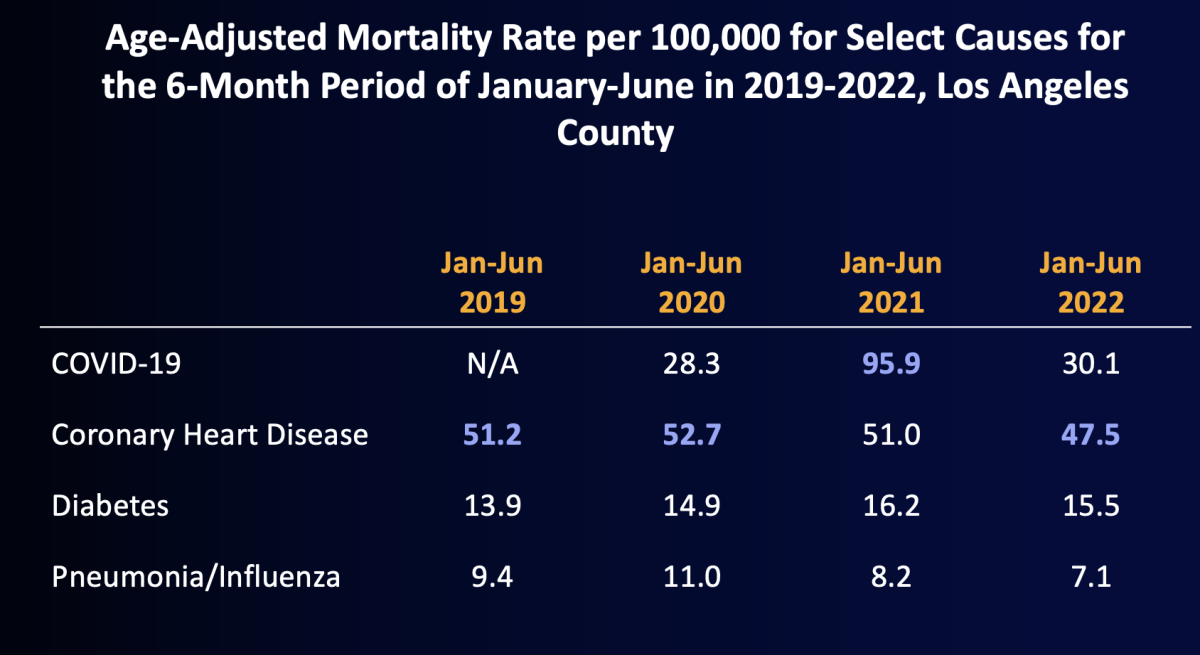
“COVID-19 has had an outsized impact on our health,” Ferrer said.
The L.A. County analysis also looked at the death rate from all causes and found that more people have been dying overall from all reasons compared to before the pandemic.
Prior to March 2020, the death rate for all reasons had been stable. For instance, in the first half of 2019, the overall death rate in L.A. County was 298.4 deaths for every 100,000 residents.
But the death rate for comparable periods over the next three years shot up to 335.7 in the first half of 2020, increased further to 399.4 for the first half of 2021 and then fell back to 335.7 in the first half of 2022. Many of the additional deaths were caused by COVID-19, the analysis found.
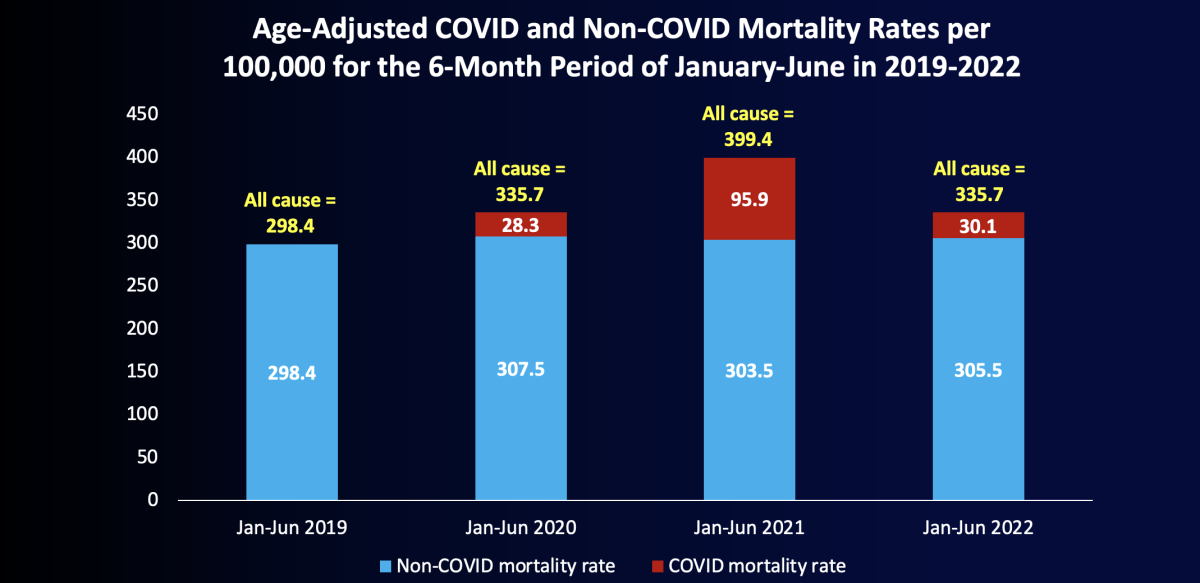
“The vast majority of these increases in all-cause mortality were due to COVID-associated deaths, but COVID deaths do not account for all of the increase,” Ferrer said. “The COVID pandemic may also have led to more deaths from other causes,” she added, such as the result of delayed care for other health conditions and hospitals being overwhelmed.
The significant reduction in the death rate between the first halves of 2021 and 2022 “is likely because this past winter, we had more tools to prevent severe illness that included boosters, [rapid coronavirus] testing and therapeutics,” Ferrer said.
After a pandemic-induced lull, influenza is being detected at increased levels for this time of year in Southern California.
Higher death rates for all causes were observed in all adult age groups for the first half of 2022 when compared to the same span in 2019.
Even among the youngest adults, up to age 29, the death rate for all causes rose by 29%; for those ages 30 to 49, the death rate rose by 36%.
By comparison, the death rate for all causes rose among those age 50 to 64 by 12%, for ages 65 to 79 by 15% and for those 80 and older by 7%.
The county analysis also found that unintentional drug overdoses were a leading cause of death during the first half of the last four years, especially for adults under 65.
Unintentional overdoses became a leading cause of death for the first time in the initial six-month period of 2020 for children under 18, and among those 50 to 64 for the first half of 2021.
During those spans in 2019 and 2021, there also was a doubling in the mortality rate from unintentional overdose deaths among the youngest adults up to age 29.
The homicide mortality rate for adults 18 to 49 rose markedly during the first six months of 2020 and 2021 compared to the comparable period in 2019, the analysis found. But the rate for the first half of 2022 appeared to be trending downward, the report found.
“Hopefully, this data allows us all to understand that COVID-19 has led to a tremendous loss of life,” Ferrer said.
Americans who still aren’t fully vaccinated against COVID-19 probably have some immunity from a past infection. They may not be so dangerous anymore.
It remains unclear how bad this winter’s COVID-19 season will be. Officials worry there will be another surge, and authorities are concerned that a lackluster uptake of the updated booster shot — generally recommended for everyone 5 and older — could lead to unnecessary infections, hospitalizations and deaths.
“It’s important for people to know that [the new Omicron booster is] really something to get right now, if you’re two months out from whatever your last COVID vaccine was,” said L.A. County health officer Dr. Muntu Davis.
Part of the problem is that many residents don’t realize that officials are recommending they get boosted again.
In front of a Vallarta Supermarkets in Boyle Heights in October, Maria Mejia and Vivian Ramirez greeted shoppers in the parking lot, offering free masks, bottles of hand sanitizer and rapid tests to detect COVID-19.
“Good morning, sir. Come over here!” Mejia called out in Spanish to one man in a baseball cap. “We’re giving out free COVID tests.”
As she bundled together the free supplies and tucked them into a pink plastic bag, she told him they had information about the vaccine that could fight the Omicron variant. The man replied that he had gotten four shots so far, but Mejia asked when his last one was. In May, he told her. She assured him he could get the updated booster now to protect himself.
The man thanked her as he left with pamphlets and supplies. Mejia estimated that only a quarter of people she approached were aware of the new and updated shots.
“The community is seeing that these new variants keep coming, so they want this information,” she said. “But most people, they don’t know about it.”
Ramirez chimed in. “Even within my household, my family did not know up until me working here,” she said.
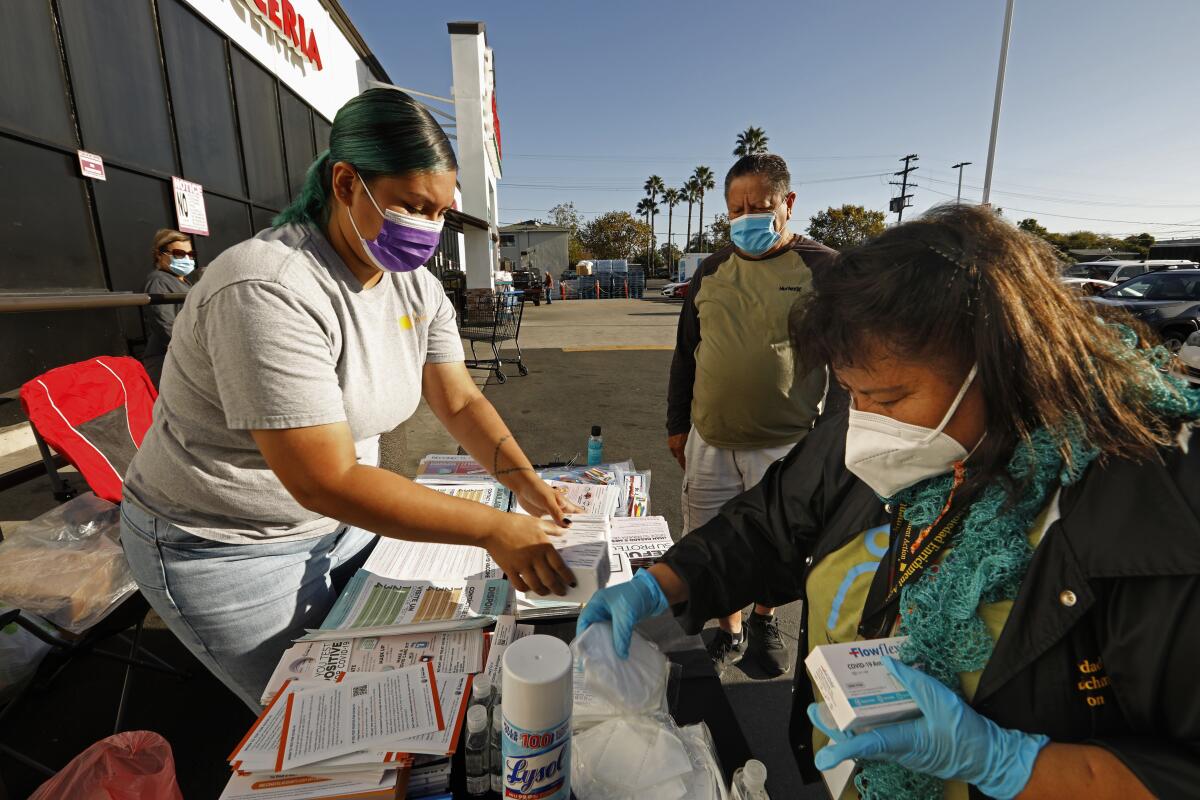
Mejia and Ramirez are community health workers with Soledad Enrichment Action, one of the nonprofits the Los Angeles County Department of Public Health has contracted to get out the word about boosters and COVID treatments. At the height of pandemic outreach, there were nearly 900 such workers across L.A. County; they now number around 400, said Tiffany Romo, a health program manager.
“It’s really just about sharing information,” Romo said. “Even in the short time we’ve been here, we’ve had people say, ‘Oh, I didn’t know. I just didn’t know’ ” about the updated Omicron booster. “So it’s not necessarily that they’re opposed to it — they just weren’t aware that they’re eligible.”
In the meantime, flu and RSV, also known as respiratory syncytial virus, remain threats. The U.S. Centers for Disease Control and Prevention says that California has moderate flu levels, an increase from the prior week.
Children’s Hospital Los Angeles is reporting an increase in flu cases, with the positivity rate at 6%, up from 2.4% the prior week. An increase in RSV and other viral illnesses continues to stretch the available capacity of the emergency room, meaning CHLA is not always able to accommodate transfers from other hospitals, according to Dr. James Stein, the chief medical officer there.
Still, CHLA is able to admit children to inpatient wards, Stein said in a statement.
The positivity rate for RSV at CHLA this week is 37%, about even from the prior week’s rate of 38%. Both figures are still far above last winter’s peak of 24%.
Both of Orange County’s two primary children’s hospitals are “operating at or beyond their capacity to care” for children with respiratory illness, with ER wait times of four to 12 hours, the Orange County health officer, Dr. Regina Chinsio-Kwong, said last week. Chinsio-Kwong declared a health emergency because of the surge.
More to Read
Sign up for Essential California
The most important California stories and recommendations in your inbox every morning.
You may occasionally receive promotional content from the Los Angeles Times.
